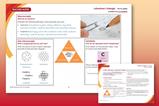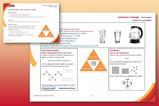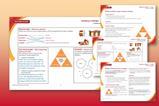How to combine chemical change, microscale and Halloween for an engaging set of lessons with 11–14 students

I’ve been lucky that chemical changes has been on the autumn term planner for 11–14 learners at my school almost every year. This means that Potions week coincides closely with Halloween. Potions week is an opportunity for me to convert my classroom into a wizarding school dungeon, straight out of popular children’s literature, complete with cauldrons, taxidermy and apothecary bottles.
The scheme of work for the start of the chemical changes topic has a few classic experiments: the reaction of magnesium with oxygen; measuring the temperature change when calcium carbonate reacts with hydrochloric acid; and observing chemical changes with a variety of reactants. These all lend themselves to a wizarding slant.
Works like a charm
First years (11- and 12-year old students) are still getting used to using equipment safely at this point. The bright white light of magnesium burning in oxygen is exciting enough in itself and Bunsen burners are still new. One of the things they need to remember is to hold the magnesium at arm’s length and not to look directly at the flame.
In a wizarding classroom the tongs become a wand. Holding the tongs stretched out away from them learners heat the 2–3 cm length of magnesium until it starts to burn bright and then hold the tongs, over a heatproof mat, while looking straight ahead and chanting the word ‘lumos’. I remind students that the incantation is intended to light up the surroundings, so they are not peering directly at the bright light of the burning magnesium but into the shadows they are trying to illuminate.
Science is magic, that works
Another favourite practical I use with 11–14 year olds is an observation of chemical changes at microscale. The purpose of this practical is to introduce learners to the type of changes that they might see during a chemical reaction; bubbles being formed, colour changes, precipitates appearing and reactants disappearing. The reactants themselves are not important in this scenario as the focus is on the changes that occur and observing and describing them.
| Chemical | Potion ingredient |
|---|---|
|
Sulfuric acid |
Spider venom |
|
Copper sulfate |
Unicorn tears |
|
Lead nitrate |
Poison (toxic) |
|
Water |
Elixir of life |
|
Zinc nitrate |
Zombie serum |
|
Calcium carbonate (chips) |
Unicorn horn |
|
Magnesium |
Dragon scales |
|
Iron filings |
Spider eggs |
|
Potassium iodide |
Eye of newt (aq) |
In this wizarding version swap the chemical names for potions. If you ask a class of 11-year olds ‘What happens when I mix sulfuric acid with calcium carbonate?’ you may well be met with anxious faces. Some of them will make assumptions based on the word acid, others will not associate a chemical name with the chips of white rock in front of them. However, use ‘What happens when you mix spider venom with powdered unicorn horn?’ and the anxiety is lost, curiosity surfaces and the pressure to give the ‘right answer’ is overcome. Learners become more engaged in the discovery and more willing to take risks (with their explanations, not their practical safety). By the end of the lesson, they will excitedly report that when you mix spider venom and unicorn horn a reaction will take place as they saw bubbles and heard fizzing. If your objective is for them to observe and describe chemical changes, then you have succeeded.
To adapt this activity for an older age group, and cover curriculum topics, you can rename any of the unknown substances in the identifying ions practical for 14–16 students. Rather than focusing on describing the reactions, ask learners to use their prior knowledge of various tests to identify and name the chemical compounds for each ‘unknown’ potion.
Bubble, bubble, toil and trouble
I encourage you to embrace the role play opportunity. I’m already quite flamboyant, so dressing up in billowing robes, sequined heels and an oversized pointed hat is not a massive step for me. However, the first teacher I observed deliver this lesson, in witches’ hat and academic gown, was usually much more soberly dressed. I was a PGCE student at the time and my mentor and colleagues told me the lesson was a must-see.
Share your aims with your technician beforehand, particularly if you want to relabel or decant reactants into different bottles. They will be able to advise you on the safety symbols to display and the types of containers you should use. Make sure the technician has a copy of the conversion table so they can dispose of spider venom safely.
I did adopt a stern character (still brilliant, but scary) while dressed up which was much more severe than my usual teaching persona. This helped to offset any potential behaviour issues that might have arisen after the initial shock had worn off. After all, I had to live up to my Potions master badge and no one wants to end up in detention in a dungeon classroom.














1 Reader's comment